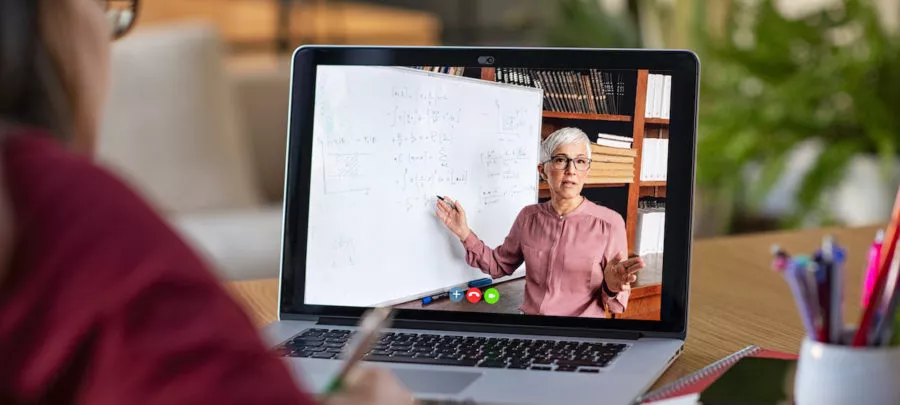“Cynthia, I can’t run my toaster oven. How am I going to run an online class? I don’t want to be an online professor. You have to help me.”
Teaching in the time of COVID-19, many of my faculty colleagues feel this way. It’s not so much that we’re being asked to suddenly become online professors. It’s more like we’re being asked to build a lifeboat—even as we’re clambering into it—to steer our students through the end of the semester.
In early March, my administration notified faculty to start preparing to move our classes online. For many of my colleagues, this is a new challenge, and one that can be a little overwhelming to consider. But I’ve taught at least one class online every semester since 1998. I’ve also been a union officer for 13 years and, for nearly a decade, ran our college’s Teaching and Learning Center.
I raised my hand to help.
Since then, I’ve been teaching dozens of my colleagues the basics of Blackboard, our college’s online course management system (CMS). Listening to their concerns, here is some advice for others who are building a lifeboat.
Stick to the basics.
No matter your discipline, in any course a professor has to do three primary things:
- Deliver content, information, materials, experiences to students;
- Receive assignments, information, ideas from students;
- Communicate with students.
Use this framework to help you focus on what you need to accomplish in an online modality. Pull out your syllabus and consider the core of what remains to be done for students to achieve the course learning outcomes. What content do you need to provide to them? What do you need students to do to show they’re achieving some mastery of that content? And in what ways do you need to communicate with your students?
Most CMSs have a course menu. It may make things simpler for your students to see the content you need to deliver in one section (syllabus, lecture notes and materials, etc.), the tools and features where students submit their work in another section, and communication tools in another area.
Think about affordances before tools.
Rather than try to learn all of the tools and features of your college’s CMS—which can be exhausting, and besides you don’t need all the bells and whistles—instead jot down what you need to accomplish. Then rely on your college’s resources (e.g., training personnel, instructional manuals, peer mentors, department colleagues) to determine which tools are best for the job. To determine affordances, I have faculty fill in sentences like this for me:
Because I need students to do __X__, I need a tool that allows me to do __Y__.
Once I have this list, I can advise which CMS tool is the simplest for the task. For example, our college uses Blackboard, and there are numerous tools by which students could submit an essay: discussion board, assignments, email, test, blog, wiki, journal. But if I know the professor wants other students to see that essay draft, I can advise against using assignments, email, or a test since those are accessible only to the instructor, and then I can share the pros and cons of the remaining options.
So it’ll save you time to ask, “I need a tool that affords me the ability to _______________,” and then the appropriate tool(s) can be identified. Again, you might need to let go of some things just to keep things simple for students.
Focus on your students—be calm, be generous, be kind.
Just like many faculty didn’t ask to be online professors, our students didn’t ask to be online students. They’re likely experiencing anxiety about this sudden shift, too. We need to stay calm to help them stay calm. This means being as prepared as we can be and even more communicative, flexible and understanding than usual.
I’ve been advising faculty to continue performing one of our most essential tasks, which is to model appropriate and professional behavior. I worry about the students who most need to be on campus, who benefit most from interacting face-to-face with other students and faculty. As much as they learn from our content and expertise, they also are learning from how we carry ourselves, how we respond to difficult situations in the classroom, how we enunciate, how we make eye contact when listening, etc. These are critical interpersonal skills that not all students have mastered.
 Cynthia Eaton of Suffolk Community College with her students. (Photo: NYSUT)
Cynthia Eaton of Suffolk Community College with her students. (Photo: NYSUT)
So, let’s keep on with that. Send emails expressing your concern about their health and well-being. Share resources around technology support or food instability. Call the ones who don’t log into your CMS or respond to your missives (there are ways to call people and have your phone number blocked on their caller ID screen).
Try offering as many synchronous opportunities as feasible. These may include videoconferencing with students or speaking by phone. Hosting an online office hour, via audio or video, can give students a chance to check in with questions and concerns; most web conferencing software enables private chats as well as group chats.
Remember: We don’t teach academic subjects, we teach students. Let’s model our best responses to this challenge.
Be patient with yourself.
As much as I’ve shared technological suggestions and solutions in recent weeks, I’m fully aware that what’s really important is not technology, but people.
Do the best you can with the time you have.
Don’t be afraid to ask for help. Rely on the people around you.
If you make a mistake, it’s okay. Apologize, if needed, using gentle humor as appropriate, then course correct and move forward. It’s okay.
Some good advice for anyone, but especially for those unaccustomed to being on a computer screen for long periods of time: Make a daily schedule and compartmentalize your work. Take regular breaks. Stand up and walk around. Stretch. Look outside to refocus your vision.
This is a stressful time for all of us, faculty and students alike, so find ways to de-stress. If this public health crisis has taught us anything, it’s that nothing matters more than our health and well-being. Be forgiving with yourself and with your students.
And, hey, if you find yourself on break while working from home, you might finally figure out how to run that toaster oven!
Cynthia Eaton is a professor and union officer at New York’s Suffolk Community College. In 2018, she was named Higher Education Member of the Year by the New York State United Teachers (NYSUT). Recently, as the COVID-19 pandemic has forced faculty to move their classes online, Eaton has been an essential advisor to her colleagues on campus.



